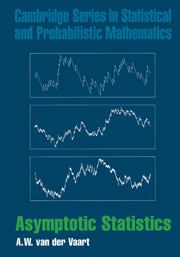Book contents
- Frontmatter
- Dedication
- Contents
- Preface
- Notation
- 1 Introduction
- 2 Stochastic Convergence
- 3 Delta Method
- 4 Moment Estimators
- 5 M–and Z-Estimators
- 6 Contiguity
- 7 Local Asymptotic Normality
- 8 Efficiency of Estimators
- 9 Limits of Experiments
- 10 Bayes Procedures
- 11 Projections
- 12 U -Statistics
- 13 Rank, Sign, and Permutation Statistics
- 14 Relative Efficiency of Tests
- 15 Efficiency of Tests
- 16 Likelihood Ratio Tests
- 17 Chi-Square Tests
- 18 Stochastic Convergence in Metric Spaces
- 19 Empirical Processes
- 20 Functional Delta Method
- 21 Quantiles and Order Statistics
- 22 L-Statistics
- 23 Bootstrap
- 24 Nonparametric Density Estimation
- 25 Semiparametric Models
- References
- Index
5 - M–and Z-Estimators
Published online by Cambridge University Press: 05 June 2012
- Frontmatter
- Dedication
- Contents
- Preface
- Notation
- 1 Introduction
- 2 Stochastic Convergence
- 3 Delta Method
- 4 Moment Estimators
- 5 M–and Z-Estimators
- 6 Contiguity
- 7 Local Asymptotic Normality
- 8 Efficiency of Estimators
- 9 Limits of Experiments
- 10 Bayes Procedures
- 11 Projections
- 12 U -Statistics
- 13 Rank, Sign, and Permutation Statistics
- 14 Relative Efficiency of Tests
- 15 Efficiency of Tests
- 16 Likelihood Ratio Tests
- 17 Chi-Square Tests
- 18 Stochastic Convergence in Metric Spaces
- 19 Empirical Processes
- 20 Functional Delta Method
- 21 Quantiles and Order Statistics
- 22 L-Statistics
- 23 Bootstrap
- 24 Nonparametric Density Estimation
- 25 Semiparametric Models
- References
- Index
Summary
This chapter gives an introduction to the consistency and asymptotic normality of M -estimators and Z-estimators. Maximum likelihood estimators are treated as a special case.
Introduction
Suppose that we are interested in a parameter (or “functional“) attached to the distribution ofobservations, …,A popular method for finding an estimator is to maximize a criterion function of the type
Here are known functions. An estimator maximizing over is called an M -estimator. In this chapter we investigate the asymptotic behavior of sequences of M -estimators.
Often the maximizing value is sought by setting a derivative (or the set of partial derivatives in the multidimensional case) equal to zero. Therefore, the name M -estimator is also used for estimators satisfying systems of equations of the type
Here are known vector-valued maps. For instance, if is k-dimensional, thentypically has k coordinate functions and (5.2) is shorthand for the system of equations
Even though in many examples is the partial derivative of some function this is irrelevant for the following. Equations, such as (5.2), defining an estimator are called estimating equations and need not correspond to a maximization problem. In the latter case it is probably better to call the corresponding estimators Z-estimators (for zero), but the use of the name M -estimator is widespread.
Sometimes the maximum of the criterion function Mn is not taken or the estimating equation does not have an exact solution. Then it is natural to use as estimator a value that almost maximizes the criterion function or is a near zero. This yields approximate M-estimators or Z-estimators. Estimators that are sufficiently close to being a point of maximum or a zero often have the same asymptotic behavior.
An operator notation for taking expectations simplifies the formulas in this chapter. We write P for the marginal law of the observations which we assume to be identically distributed. Furthermore, we write for the expectation and abbreviate the average. Thus Pn is the empirical distribution: the (random) discrete distribution that puts mass at every of the observations.
Information
- Type
- Chapter
- Information
- Asymptotic Statistics , pp. 41 - 84Publisher: Cambridge University PressPrint publication year: 1998
Accessibility standard: Unknown
Why this information is here
This section outlines the accessibility features of this content - including support for screen readers, full keyboard navigation and high-contrast display options. This may not be relevant for you.Accessibility Information
- 1
- Cited by
